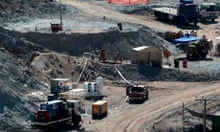The miners trapped underground in Chile will have to move up to 4,000 of tonnes of rock that will be sent crashing into their tunnel by the drill that last night began boring a rescue shaft to save them.
As work started on a pilot hole to reach the 33 men who have already spent 26 days below the surface, engineers revealed the men would have to help their own escape by clearing debris expected to be created hundreds of metres from their shelter.
They will have to work in round-the-clock shifts to move the crushed rock using wheelbarrows and industrial-sized battery-powered sweepers already in the tunnels, although it could be one or two months before they are called into action. It could be 16 weeks before the miners are lifted to the surface in a capsule sent down the shaft.
Meanwhile food, medical supplies, replacement clothing, sleeping mats, videos and even portable PlayStations have been dropped to the men through other small bore holes drilled in recent weeks. A team from Nasa is on its way to the mine, 500 miles (800km) north of Santiago, to advise on helping the miners cope with tough physiological and psychological conditions. The men have already amazed those seeking to rescue them. They were discovered alive 17 days after the original landslide that caused a tunnel to collapse and trap them 700m (2,300ft) underground, having survived by eking out emergency rations, including tuna, milk and biscuits, designed to last 48 hours. The men also found water by digging into the ground.
The first step in reaching the miners is to complete another pilot hole, just over a foot wide. Larger machine cutters will slowly widen the hole to double its size. But the widening will send rock crashing into an area a few hundred metres from the miners' shelter. That could plug the hole and delay the rescue, meaning that the men themselves must move the debris.
"The miners are going to have to take out all that material as it falls," said Andrés Sougarret, head engineer on the operation. There would be room for men to store the rocks, he added, but could not say how long the work might take.
The drilling team would also have to decide whether to fit the wider hole with metal casing to prevent collapses in the walls. "We may not have to use it in this case because the rock is really high quality, really strong," he said.
The trapped men were able to speak briefly to their families on a telephone link on Sunday; previously they had only sent video messages. Portions of the calls were made public, including a promise by miner Esteban Rojas that he would marry his girlfriend of 25 years when he has been rescued.
One of the miners has basic medical training and has already vaccinated the men against tetanus and diphtheria. He is expected also to give them flu vaccinations. Nicotine patches have been provided for smokers.
Treatment for fungal infections and sores have also been sent to the miners, along with dry clothes including socks and lightweight boots. Videos of recent football matches have also been provided to keep the men entertained.
The Chilean mining minister, Laurence Golborne, has rejected local reports citing engineers who said the rescue could be done in much less than the quoted three to four months. He said experts had analysed 10 different methods to get the men out and would continue to study other options, but "nothing has yet been found that will be quicker".


